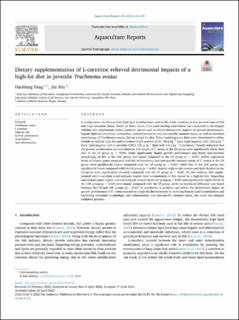| dc.description.abstract | In recent years, the dramatically high lipid level has been used in fish feeds, resulting in low survival rates of fish and huge economic losses. Based on these issues, a six-week feeding experiment was conducted to investigate whether diet supplements with L-carnitine can be used to relieve detrimental impacts on growth performance, hepatic lipid accumulation, antioxidant, anti-inflammatory and non-specific immune status, as well as intestinal morphology of Trachinotus ovatus, fed on a high-fat diet. Three isonitrogenous diets were formulated to either include or exclude high-fat and L-carnitine (lipid positive (LP): 130 g kg−1 lipid, lipid negative (LN): 210 g kg−1 lipid, lipid negative with L-carnitine (LNC): 210 g kg−1 lipid with 0.6 g kg−1 L-carnitine). Results indicated that the growth performance and mid-intestine villi length of T. ovatus in the LN group were significantly lower than that of the LP group (p < 0.05), while significantly higher growth performance and better mid-intestine morphology of fish in the LNC group was found compared to the LN group (p < 0.05). mRNA expression levels of hepatic genes associated with the inflammatory and non-specific immune statue of T. ovatus in the LN group were significantly higher compared with the LP group (p < 0.05), while that of the LNC group was significantly lower compared with the LN group (p < 0.05). Hepatic triglyceride content and lipid droplets in the LN group were significantly elevated, compared with the LP group (p < 0.05). On the contrary, diet supplemented with L-carnitine could mitigate hepatic lipid accumulation in fish caused by a high-fat diet. Regarding antioxidant states, higher malondialdehyde content in the LN group (p > 0.05) and significantly higher levels in the LNC group (p < 0.05) were found, compared with the LP group, while no statistical difference was found between the LN and LNC groups (p > 0.05). In conclusion, L-carnitine can relieve the detrimental impact on growth performance of T. ovatus exposed to a high-fat diet treatment by reducing hepatic lipid accumulation and improving intestinal morphology, anti-inflammatory and non-specific immune status, but could not mitigate oxidative pressure. | en_US |
